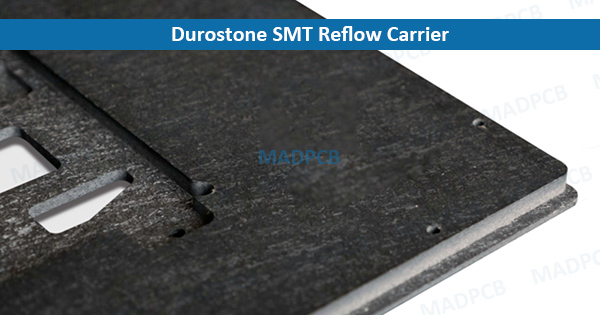Table of Contents
SMT Reflow Carrier
Solder paste printing, SMD placement and reflow soldering, all are surface mount technology (SMT) processes, which have demands of SMT tooling, and can maximize SMT efficiency from the use of them. Commonly used SMT tooling include stencil, test jig and reflow carrier. Today, we present all about Reflow Carrier, also called SMT Carrier, PCB Pallet or SMT Pallet, which plays the role of support and transport printed circuit board (PCB) in all these SMT processes.
Sometimes, rigid board assembly may or may not requires reflow carrier, but if you are working with flex PCB assembly, your SMT assembly absolutely requires it. Reflow carrier is often an essential part of achieving consistent, highest quality success with new product introduction (NPI) or high-volume PCB assembly runs. This tool is not new to the electronic manufacturing industry, and it’s a proven part of designing a robust PCB assembly process. Oftentimes only mechanical support is considered when deciding to use of reflow carriers, but there are many purposes and advantages.
Purposes and Advantages of SMT Carrier
Whenever reflow carriers are being considered and/or evaluated, take the time necessary to remind yourself of the benefits of using an carrier and how you would want it designed. There is a short of items to consider when reviewing the advantages of reflow carriers and the design elements that are important.
Preventing Rigid & Flex PCB Warpage
Providing mechanical support throughout the entire SMT line (top and bottom assembly) can reduce warpage of rigid PCBs, rigid-flex boards and flex circuits that can significantly reduce yields. SMT carriers prove to be really essential when processing thinner substrates, but quite often prove beneficial with substrates that are considered “thick”. The specific design features chosen for a given SMT pallet are critical to minimizing warpage. Threaded inserts may be utilized to secure the PCB board to the carrier within the reflow process.
Utilizing tapered tooling pins located in the tooling holes of the circuit board (plated or non-plated), a wedge effect is created to secure the printed board to the PCB pocket during solder paste screen print, pick and place, and reflow processes. Tension or pressure against these tapered pins is generated by utilizing flush-mounted “pushers” with varying spring K-factors (dependent upon PCB board thickness and stack-up characteristics) helping to maintain printed board flatness throughout the entire process.
Improved Stencil Alignment after De-paneling
Printing smaller images after de-paneling operations can improve yields when fine pitch devices are present. PCB boards are oftentimes received in a de-paneled condition and the reflow carrier is the only solution to conveying and processing the SMT assembly. Proceed with caution when deciding the number of images to place into one carrier. Productivity is obviously improved as the quantity increases, but stencil-to-PCB alignment is reduced exponentially with each image added.
Vision and Alignment
Reflow carriers can provide the required or additional fiducials needed to achieve optimum stencil registration and SMD placement accuracy. Ask the tooling provider to explain how they design and fabricate carrier fiducials to be robust and easily seen with your process equipment.
Conveyance
Many “odd-shaped” PC board layouts are not easily conveyed through SMT process equipment and carriers provide solid edge step features making smooth conveyance a non-issue. Pay attention to the edge step thickness whenever a carrier is designed.
Edge Clearance
Parts too close to the PCB board edge are at risk of being damaged during first or second side assembly processing without an SMT carrier. SMT carriers can be designed with clearance for these parts (on either side) while still providing solid support for the rest of the printed circuit boards.
Process Standardization
Machine and/or line changeover can be reduced if a standard carrier design (width, thickness, material) is used with all the assemblies in your portfolio of products. For single-sided processing, reflow carriers can often be used in other “downstream” processes such as AOI or electrical testing. SMT tooling can also eliminate the need for high-cost vacuum or custom support plates in printing or placement equipment. Carriers also provide the added benefit of not creating additional operator training, engineer support, or equipment maintenance support.
Protection /Heat Shielding
Heat-sensitive components can often be shielded through the secondary reflow process. A robust design will also distribute temperatures evenly across the PCB board minimizing thermal impact.
Critical Alignment of Parts
Top cover alignment plates or integrated carrier features can help achieve critical alignment or spacing of parts such as edge connectors during reflow.
Creating a Unique Reflow Carrier
Creating each SMT carrier for each unique circuit board assembly is critical to the success. A through understanding of thermodynamics and the effects a composite carrier will have in the reflow environment is an essential part of the success or failure of any carrier.
Reflow Carrier Material: Durostone
When visit PCB assembly house, you may see dark grey smt carriers on each machine and conveyor with the SMT line. What’s the carrier material? Many people concern this question. In MADPCB, carrier material is always Nanometer Composite Stone, also called Durostone, but sometimes is Aluminum. Durostone is the most commonly used when making reflow carriers. Durostone is a heavy-duty glass fiber reinforced plastic, which offers extreme strength and excellent mechanical and thermal properties at elevated temperatures and are dimensionally stable and retain carriers flatness through repeated reflowing cycles in SMT process. Durostone is manufactured by using Polyester (PET), Vinylester, Epoxid- and modified Epoxy resins, combined with carbon, glass, or basalt fiber reinforcements. Durostone carriers can be continuous used again over 20,000 time under high temperatures. SMT carriers manufactured with durostone bring a lot of benefits to all PCB and assembly manufacturers. SMT carrier cost is NRE charge, and you can consider it as a valuable tooling option that will have a short return on investment period.

